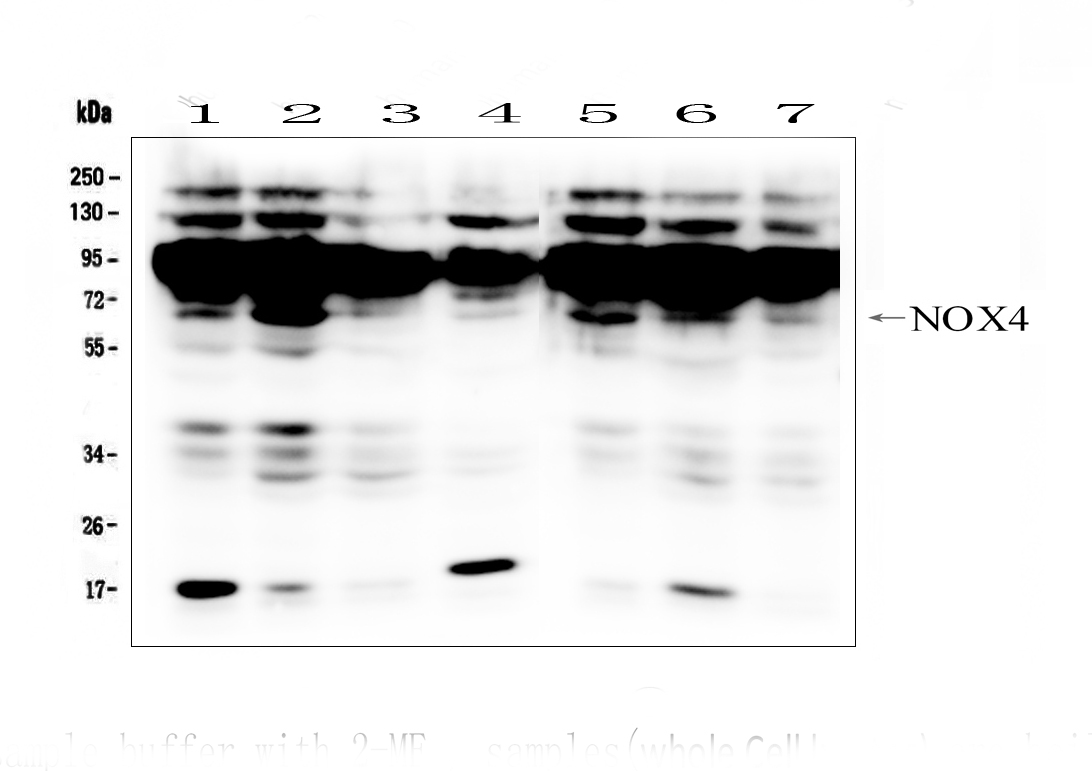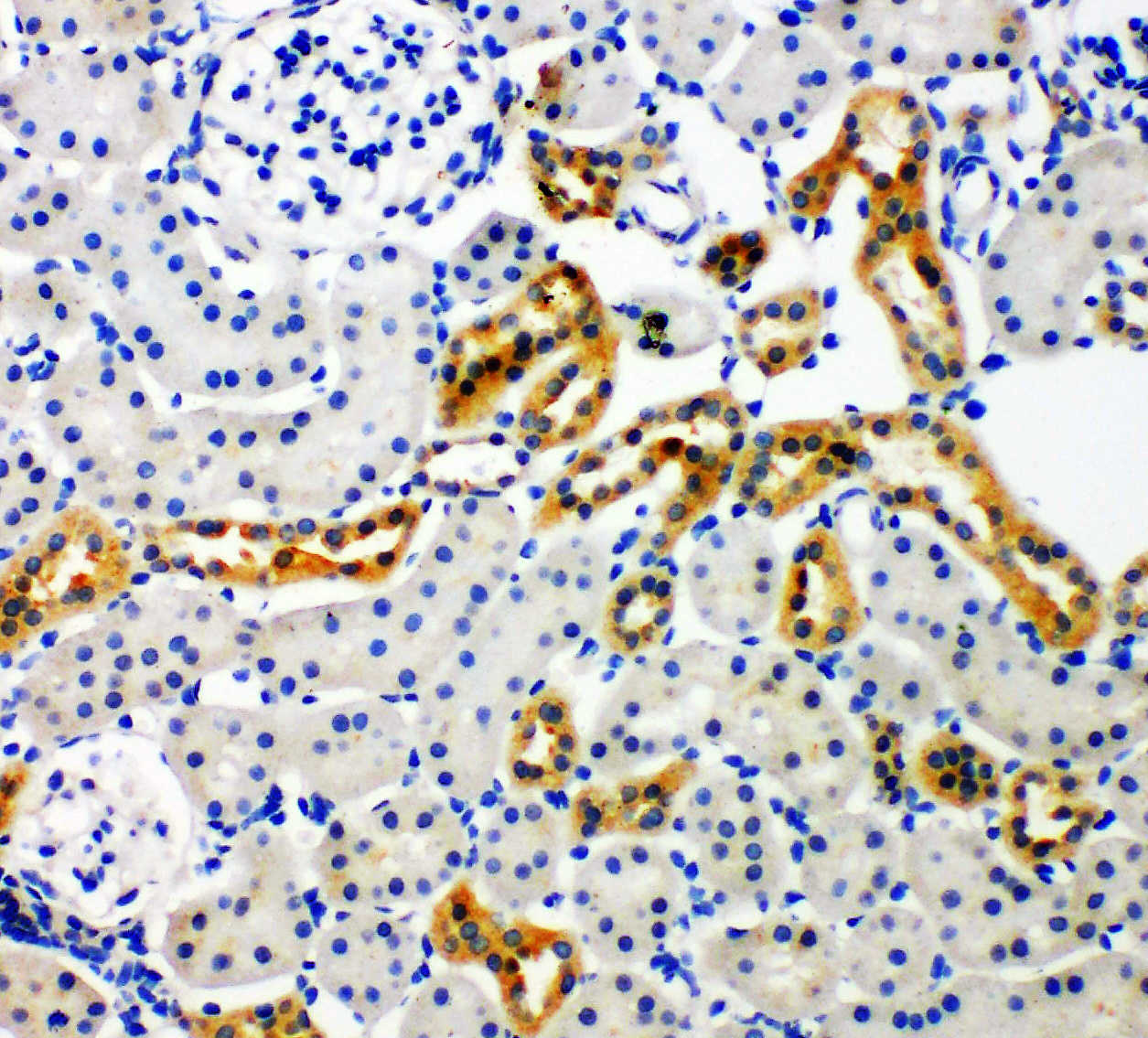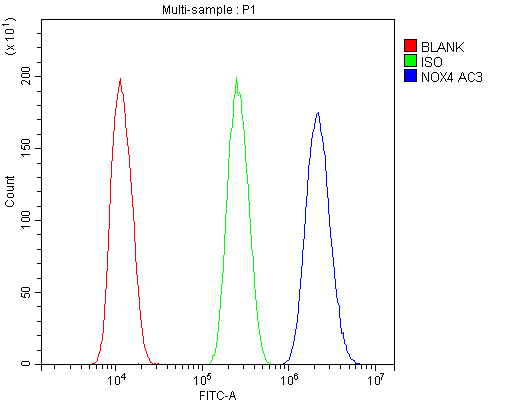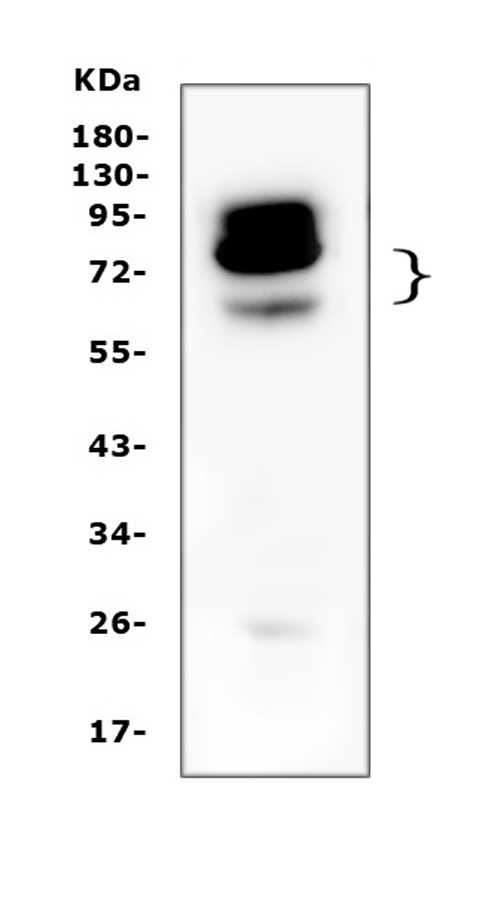| Western blot (WB): | 1:500-2000 |
| Immunohistochemistry (IHC): | 1:50-400 |
| Flow Cytometry (Fixed): | 1:50-200 |
| (Boiling the paraffin sections in 10mM citrate buffer,pH6.0,or PH8.0 EDTA repair liquid for 20 mins is required for the staining of formalin/paraffin sections.) Optimal working dilutions must be determined by end user. | |

Figure 1. Western blot analysis of NADPH oxidase 4/NOX4 using anti-NADPH oxidase 4/NOX4 antibody (BA2813). Electrophoresis was performed on a 5-20% SDS-PAGE gel at 70V (Stacking gel) / 90V (Resolving gel) for 2-3 hours. The sample well of each lane was loaded with 50ug of sample under reducing conditions. Lane 1: human HepG2 whole cell lysates, Lane 2: human SW620 whole cell lysates,Lane 3: human HK-2 whole cell lysates, Lane 4: human HL-60 whole cell lysates,Lane 5: human 293T whole cell lysates,Lane 6: human SW579 whole cell lysates,Lane 7: human SK-OV-3 whole cell lysates.After Electrophoresis, proteins were transferred to a Nitrocellulose membrane at 150mA for 50-90 minutes. Blocked the membrane with 5% Non-fat Milk/ TBS for 1.5 hour at RT. The membrane was incubated with rabbit anti-NADPH oxidase 4/NOX4 antigen affinity purified polyclonal antibody (Catalog # BA2813) at 0.5 μg/mL overnight at 4°C, then washed with TBS-0.1%Tween 3 times with 5 minutes each and probed with a goat anti-rabbit IgG-HRP secondary antibody at a dilution of 1:10000 for 1.5 hour at RT. The signal is developed using an Enhanced Chemiluminescent detection (ECL) kit (Catalog # EK1002) with Tanon 5200 system. A specific band was detected for NADPH OXIDASE 4/NOX4 at approximately 67KD. The expected band size for NADPH OXIDASE 4/NOX4 is at 67KD.

Figure 2. IHC analysis of NADPH OXIDASE 4/NOX4 using anti-NADPH OXIDASE 4/NOX4 antibody (BA2813).NADPH OXIDASE 4/NOX4 was detected in paraffin-embedded section of rat kidney tissues. Heat mediated antigen retrieval was performed in citrate buffer (pH6, epitope retrieval solution) for 20 mins. The tissue section was blocked with 10% goat serum. The tissue section was then incubated with 1μg/ml rabbit anti-NADPH OXIDASE 4/NOX4 Antibody (BA2813) overnight at 4°C. Biotinylated goat anti-rabbit IgG was used as secondary antibody and incubated for 30 minutes at 37°C. The tissue section was developed using Strepavidin-Biotin-Complex (SABC)(Catalog # SA1022) with DAB as the chromogen.

Figure 3. Flow Cytometry analysis of U2OS cells using anti-NADPH oxidase 4/NOX4 antibody (BA2813).
Overlay histogram showing U2OS cells stained with BA2813 (Blue line).The cells were blocked with 10% normal goat serum. And then incubated with rabbit anti- NADPH oxidase 4/NOX4 Antibody (BA2813, 1:100) for 30 min at 20°C. DyLight488 conjugated goat anti-rabbit IgG (BA1127, 1:100) was used as secondary antibody for 30 minutes at 20°C. Isotype control antibody (Green line) was rabbit IgG (1:100) used under the same conditions. Unlabelled sample (Red line) was also used as a control.

Figure 4. Western blot analysis of NADPH oxidase 4/NOX4 using anti-NADPH oxidase 4/NOX4 antibody (BA2813).
Electrophoresis was performed on a 5-20% SDS-PAGE gel at 70V (Stacking gel) / 90V (Resolving gel) for 2-3 hours. The sample well of each lane was loaded with 50ug of sample under reducing conditions.
Lane 1: rat kidney tissue lysate.
After Electrophoresis, proteins were transferred to a Nitrocellulose membrane at 150mA for 50-90 minutes. Blocked the membrane with 5% Non-fat Milk/ TBS for 1.5 hour at RT. The membrane was incubated with rabbit anti-NADPH oxidase 4/NOX4 antigen affinity purified polyclonal antibody (Catalog # BA2813) at 0.5 μg/mL overnight at 4°C, then washed with TBS-0.1%Tween 3 times with 5 minutes each and probed with a goat anti-rabbit IgG-HRP secondary antibody at a dilution of 1:10000 for 1.5 hour at RT. The signal is developed using an Enhanced Chemiluminescent detection (ECL) kit (Catalog # EK1002) with Tanon 5200 system. Specific bands were detected for NADPH oxidase 4/NOX4 at approximately 67-80KD. The expected band size for NADPH oxidase 4/NOX4 are at 67-80KD.

Figure 1. Western blot analysis of NADPH oxidase 4/NOX4 using anti-NADPH oxidase 4/NOX4 antibody (BA2813). Electrophoresis was performed on a 5-20% SDS-PAGE gel at 70V (Stacking gel) / 90V (Resolving gel) for 2-3 hours. The sample well of each lane was loaded with 50ug of sample under reducing conditions. Lane 1: human HepG2 whole cell lysates, Lane 2: human SW620 whole cell lysates,Lane 3: human HK-2 whole cell lysates, Lane 4: human HL-60 whole cell lysates,Lane 5: human 293T whole cell lysates,Lane 6: human SW579 whole cell lysates,Lane 7: human SK-OV-3 whole cell lysates.After Electrophoresis, proteins were transferred to a Nitrocellulose membrane at 150mA for 50-90 minutes. Blocked the membrane with 5% Non-fat Milk/ TBS for 1.5 hour at RT. The membrane was incubated with rabbit anti-NADPH oxidase 4/NOX4 antigen affinity purified polyclonal antibody (Catalog # BA2813) at 0.5 μg/mL overnight at 4°C, then washed with TBS-0.1%Tween 3 times with 5 minutes each and probed with a goat anti-rabbit IgG-HRP secondary antibody at a dilution of 1:10000 for 1.5 hour at RT. The signal is developed using an Enhanced Chemiluminescent detection (ECL) kit (Catalog # EK1002) with Tanon 5200 system. A specific band was detected for NADPH OXIDASE 4/NOX4 at approximately 67KD. The expected band size for NADPH OXIDASE 4/NOX4 is at 67KD.

Figure 2. IHC analysis of NADPH OXIDASE 4/NOX4 using anti-NADPH OXIDASE 4/NOX4 antibody (BA2813).NADPH OXIDASE 4/NOX4 was detected in paraffin-embedded section of rat kidney tissues. Heat mediated antigen retrieval was performed in citrate buffer (pH6, epitope retrieval solution) for 20 mins. The tissue section was blocked with 10% goat serum. The tissue section was then incubated with 1μg/ml rabbit anti-NADPH OXIDASE 4/NOX4 Antibody (BA2813) overnight at 4°C. Biotinylated goat anti-rabbit IgG was used as secondary antibody and incubated for 30 minutes at 37°C. The tissue section was developed using Strepavidin-Biotin-Complex (SABC)(Catalog # SA1022) with DAB as the chromogen.

Figure 3. Flow Cytometry analysis of U2OS cells using anti-NADPH oxidase 4/NOX4 antibody (BA2813).
Overlay histogram showing U2OS cells stained with BA2813 (Blue line).The cells were blocked with 10% normal goat serum. And then incubated with rabbit anti- NADPH oxidase 4/NOX4 Antibody (BA2813, 1:100) for 30 min at 20°C. DyLight488 conjugated goat anti-rabbit IgG (BA1127, 1:100) was used as secondary antibody for 30 minutes at 20°C. Isotype control antibody (Green line) was rabbit IgG (1:100) used under the same conditions. Unlabelled sample (Red line) was also used as a control.

Figure 4. Western blot analysis of NADPH oxidase 4/NOX4 using anti-NADPH oxidase 4/NOX4 antibody (BA2813).
Electrophoresis was performed on a 5-20% SDS-PAGE gel at 70V (Stacking gel) / 90V (Resolving gel) for 2-3 hours. The sample well of each lane was loaded with 50ug of sample under reducing conditions.
Lane 1: rat kidney tissue lysate.
After Electrophoresis, proteins were transferred to a Nitrocellulose membrane at 150mA for 50-90 minutes. Blocked the membrane with 5% Non-fat Milk/ TBS for 1.5 hour at RT. The membrane was incubated with rabbit anti-NADPH oxidase 4/NOX4 antigen affinity purified polyclonal antibody (Catalog # BA2813) at 0.5 μg/mL overnight at 4°C, then washed with TBS-0.1%Tween 3 times with 5 minutes each and probed with a goat anti-rabbit IgG-HRP secondary antibody at a dilution of 1:10000 for 1.5 hour at RT. The signal is developed using an Enhanced Chemiluminescent detection (ECL) kit (Catalog # EK1002) with Tanon 5200 system. Specific bands were detected for NADPH oxidase 4/NOX4 at approximately 67-80KD. The expected band size for NADPH oxidase 4/NOX4 are at 67-80KD.



